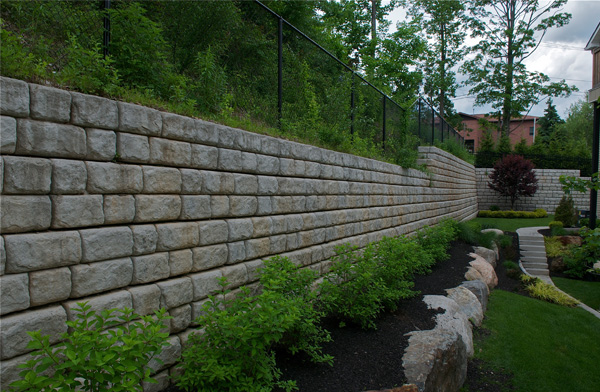Are you looking for ways to spruce up your yard or garden? Do you want to create more usable space on a sloped property? If so, you may want to consider installing a retaining wall. But what exactly is a retaining wall? This article will explore what retaining walls are, why they are installed, and where they are commonly found.
What is a Retaining Wall?
A retaining wall is a structure that is built to hold back soil or rock from a slope. It is usually constructed from concrete, stone, or brick. Retaining walls can be used for both functional and aesthetic purposes. Functional retaining walls help to stabilize the soil on a sloped property and prevent erosion. They can also be used to create level spaces on sloped properties that would otherwise be unusable. Aesthetically, retaining walls can add interest and beauty to a landscape.
Where are Retaining Walls Installed?
Retaining walls are most commonly found in areas with steep slopes or grades. They are also often used around swimming pools, patios, and gardens to create more level spaces.
Why are Retaining Walls Installed?
Retaining walls are installed for both functional and aesthetic purposes. As mentioned earlier, functional retaining walls help to stabilize the soil on a sloped property and prevent erosion. Aesthetically, retaining walls can add interest and beauty to a landscape. In addition, retaining walls can be used to create level spaces on sloped properties that would otherwise be unusable.
Important Facts about Retaining Walls
There are a few important things you should know if you are considering installing a retaining wall on your property:
- Retaining walls must be designed and engineered by a professional to ensure that they are structurally sound.
- Retaining walls must be built with footings (a foundation of concrete or stone that extends below the frost line) to prevent them from shifting or sinking over time.
- Retaining walls must be built with drainage in mind. A drainage system should be installed behind the retaining wall to allow water to drain away from the property.
- Retaining walls must be built with proper reinforcement (e.g., steel rebar). Otherwise, they may crack or collapse over time.
DIY vs. Professional Installation
While installing a retaining wall yourself is possible, it is highly recommended that you hire a professional contractor to do the job. This is because a professional must design and engineer retaining walls to ensure that they are structurally sound. In addition, retaining walls must be built with footings (a foundation of concrete or stone that extends below the frost line) to prevent them from shifting or sinking over time.
A professional contractor will also have the necessary equipment to build a retaining wall, such as a Bobcat or other excavator. Finally, a professional contractor will be familiar with local building codes and regulations related to retaining walls.
Frequently Asked Questions About Retaining Walls
Here are a few frequently asked questions about retaining walls:
How much does it cost to install a retaining wall?
The cost of installing a retaining wall varies depending on the size and type of wall you choose. Expect to pay anywhere from $25 to $50 per square foot for a professionally installed retaining wall.
How long do retaining walls last?
Retaining walls can last for many years if they are properly designed and constructed. However, poor drainage or inadequate reinforcement can cause a retaining wall to fail prematurely.
Can I install a retaining wall myself?
While installing a retaining wall yourself is possible, it is highly recommended that you hire a professional contractor to do the job. This is because a professional must design and engineer retaining walls to ensure that they are structurally sound.
Will a retaining wall increase the value of my property?
A retaining wall can increase the value of your property by improving its curb appeal and making it more functional. In addition, a retaining wall can create level spaces on sloped properties that would otherwise be unusable.
Do I need a permit to install a retaining wall?
In most cases, you will need a permit to install a retaining wall. Check with your local building department to find out if a permit is required in your municipality.
Do I need to waterproof my retaining wall?
It is a good idea to waterproof your retaining wall, especially if it is built with concrete or stone. Waterproofing will help to prevent water from seeping into the wall and causing it to deteriorate prematurely.
What are the best materials for a retaining wall?
The best materials for a retaining wall depend on the purpose of the wall and the look you want to achieve. For example, natural stone walls are often used for decorative purposes, while interlocking concrete blocks are often used for functional purposes. Ultimately, the best material for your retaining wall will be determined by your budget, aesthetic preferences, and the advice of a professional contractor.
Retaining walls are installed for both functional and aesthetic purposes. Functional retaining walls help to stabilize the soil on a sloped property and prevent erosion. Aesthetically, retaining walls can add interest and beauty to a landscape. In addition, retaining walls can create level spaces on sloped properties that would otherwise be unusable.
If you are considering installing a retaining wall on your property, it is important to hire a professional contractor to do the job. This is because a professional must design and engineer retaining walls to ensure that they are structurally sound.
If you are considering installing a retaining wall on your property, contact a professional contractor today for more information.






